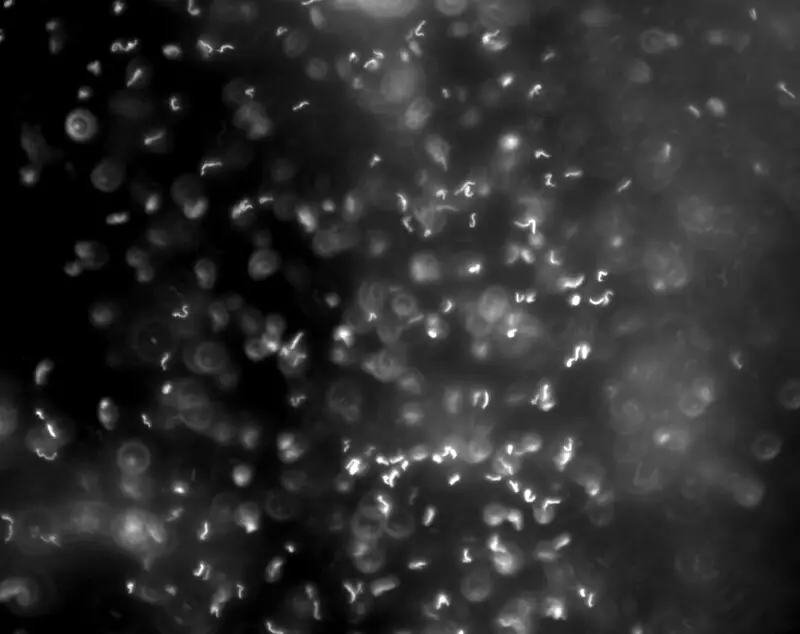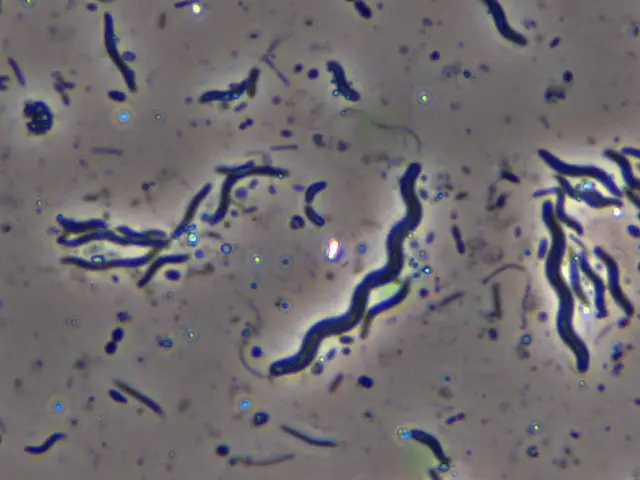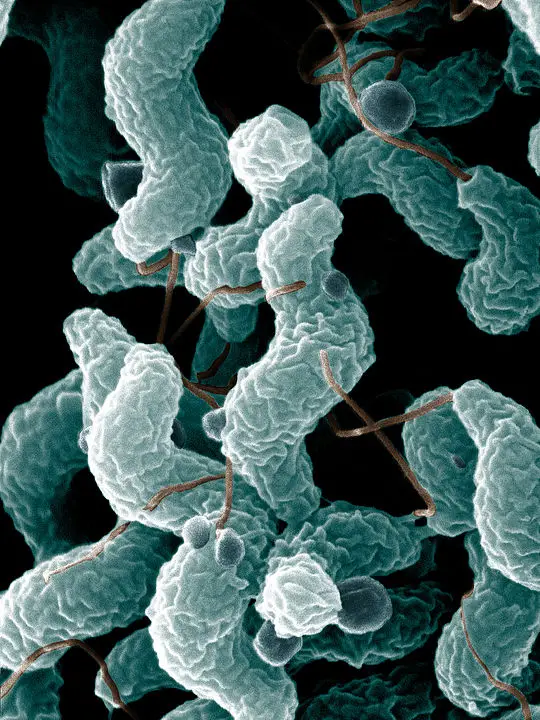Spirilla Bacteria
Definition, Examples, Shape, Diseases
What is Spirilla (Singular, Spirillum)?
Spirilla (singular, Spirillum) are a group of bacteria characterized by a corkscrew (spiral) appearance. They are Gram-negative bacteria and are characterized by motile structures known as flagella. With the exception of one species, members of this group are commonly found in aquatic habitats where they are capable of swimming rapidly.
Although some of the species live freely in certain aquatic habitats, some Spirilla are responsible for various diseases in human beings and animals. For a long time, Spirilla bacteria were classified under the genus Spirillum.
Based on a number of physiological and composition differences, etc, the genus has been divided into three main genera that include:
- Spirillum
- Aquaspirillum
- Ocenospirillum
The genus Spirillum was created in 1832 by Gottfried Ehrenberg, a German naturalist, anatomist, and microscopist. However, as many species began to be discovered over time, it became evident that they did not belong to the same group.
For this reason, scientists like Phillip B. Hylemon and J. Scott Wells proposed that the group be further divided into several genera. Today, as already mentioned, Spirilla are divided into three main genera.
These include:
Oceanospirillum
Some examples of Oceanospirillum bacteria include; O. linum, O. minutulum, 0. beijerinckii, and O. japonicum.
Like the other Spirilla bacteria, members of this genus are small in size and range from 0.4 to 1.4 um in diameter (and 1.2 to 75um in length). As the name suggests, Oceanospirillum bacteria are commonly found in marine environments. Here, they exist as aerobic chemoheterotrophic organisms and thus have a respiratory type of metabolism (they do not ferment carbohydrates).
As marine organisms, research studies have shown these organisms to rely on a medium that contains seawater for their growth. As such, they are unable to grow in an environment that does not provide this condition (e/.g freshwater-based medium). As compared to other Spirilla, Oceanospirillum has also been shown to contain DNA mol% G+C of between 42 and 48 percent.
Shape
Like other Spirilla bacteria, members of the genus Oceanospirillum are characterized by a spiral shape. However, this shape may vary from a fibroid shape which has a single complete turn, to a helical shape with several complete turns depending on the species.
As well, a few species in this group have been shown to have a rod-like shape (straight rods). In particular, changes in shape (to straight rods or coccoid) have been associated with prolonged culture of these organisms.
For instance, following the prolonged culture of O. japonicum, researchers noticed that the general shape of these cells changed from elongated, helical cells with more than one complete turn (before culture) to slightly curved or s-shape.
For members of this genus with a helical shape, all species that have been examined (with the exception of O. pusillum) have a characteristic clockwise helix. Motility of these organisms is made possible by one or several flagella located at one or both poles of the cell body.
Apart from the typical plasma membrane, all Oceanospirillum species have a special type of membrane known as polar membrane. This membrane is usually located on the regions that contain the flagella and is linked to the inner part of the plasma membrane by bar-like links.
Apart from the polar membrane, all species have also been shown to contain intracellular poly-b-hydroxybutyrate (PHB). This is a polymer (a form of β-OHB) that is used by Oceanospirillum among other bacteria as an energy store.
Coccoid bodies - As previously mentioned, Oceanospirillum has been shown to form coccoid bodies in old cultures also known as microcysts, the coccoid bodies are characterized by thin walls and tend to be resistant to lyses when placed in distilled water.
In culture, they can be formed when two cells entwin. Here, the entwined cells fuse and gradually become shorter in shape and thicker consequently forming the coccoid body. A cell also may shorten and become more round in shape ultimately forming a coccoid body.
When placed in fresh media, these coccoid bodies can germinate. Here, the germination is typically characterized by unipolar (or bipolar) growth to form a helical cell. Under favorable conditions, such as natural seawater, germinated cells will have the typical helical shape with one or several complete turns.
In such media as PSS seawater agar, the organisms form colonies within a period of 2 to 3 days. These colonies may appear white in color with a diameter of about 1.5mm. However, the color may change to pale yellow or yellow-green depending on the species or culture conditions.
Aquaspirillum
Examples
Some examples of species that belong to the genus Aquaspirillum include A. fasciculus, A. peregrinum, A. serpens, A. polymorphum, A. itersonii, A. magnetotacticum, A. dispar, and A. bengal.
Unlike Oceanospirillum, Aquaspirillum are commonly found in freshwater habitats. They have been identified in ditches, canal water, as well as sewage among other stagnant water bodies. Some of the species have also been found in a number of other habitats including streams, pond water, and some soil samples.
Given that members of the genus Aquaspirillum reside in freshwater habitats, they do not grow under saline conditions (they have low salt tolerance and cannot grow in culture with 3 percent sodium chloride and above).
While they are also aerobic organisms, like Oceanospirillum, they have a relatively higher G+C content. Based on molecular studies, the G+C content of these organisms has been shown to range from 50 to 65 mol%. This, along with the fact that the majority of species in this group are found in freshwater habitats is some of the factors used to group these organisms in a different genus.
Like many other bacteria, Aquaspirillum bacteria are very small in size, ranging from 0.2 to 1.4 in diameter. Although the majority of the species in the group are aerobic (with some of the species being microaerobic) and use respiratory metabolism, a few of the species have been shown to be capable of growing anaerobically (using nitrate). As such, they are capable of nitrogen fixation where nitrogenase is used to reduce nitrogen sources. However, this only occurs under microaerobic conditions.
Shape
Like members of the genus Oceanospirillum, Aquaspirillum species are rigid helical cells. As such, they are characterized by a helical or spiral shape. While this shape is common for the majority of species, researchers have identified a few species that either have a vibrioid or curved shape (A. fasciculus, on the other hand, are straight rods). The type of flagella has also been shown to vary between the species.
Whereas a good number of species use bipolar tufts for locomotion in freshwater habitats (e.g. in A. polymorphum), a few species only have a single flagellum located on each pole of the cell while one of the species is monotrichous and thus has a single flagellum located on one pole of the cell body (e.g. in A. delicatum).
Unlike Oceanospirillum, the majority of Aquaspirillum do not form coccoid bodies in old cultures (some of the species that form coccoid bodies include A. peregrinum and A. fasciculus). Although the majority of species have a helical shape, repeated culture, and serial transfer has been shown to cause a good number to gradually develop a straight-rod appearance.
With regards to cell structure, some of the other characteristics of Aquaspirillum include:
· Have a polar membrane that is attached to the cytoplasmic membrane at the polar ends of the cell
· With the exception of two species, they have Intracellular poly -β-hydroxybutyrate
· Are chemoorganotrophs
· Cell wall contains an array of protein macromolecules
· When cultured on PSS agar, they produce a yellow-green pigment
· Some of the species exhibit a counterclockwise helix
Spirillum
Examples
Currently, only three species are included in the genus Spirillum. These include Spirillum volutans, Spirillum winogradskyi, and Spirillum minus.
Members of the genus Spirillum are characterized by a G+C content of about 38 mol% and are commonly found in freshwater environments (with the exception of S. minus). Like all the other Spirilla bacteria, all members of this group are Gram-negative.
They are also mostly microaerophilic and thus require a low level of oxygen to survive. However, based on culture techniques, studies have shown that they can grow aerobically in certain liquid media (media with special supplements).
As microaerophiles, metabolism is strictly respiratory with oxygen being the terminal electron acceptor. Here, then, anaerobic growth does not occur like some of the other Spirilla.
Shape
As compared to the other Spirilla, members of the genus Spirillum are relatively larger, ranging from 1.4 to 1.7um in diameter (S. volutans can grow to be 8um in diameter). Some members can grow to about 60um in length.
With regards to shape, Spirillum bacteria also have a helical shape (spiral) with one to about 5 complete helical turns. However, there have been instances where microscopic studies have revealed an incomplete helical turn. Locomotion is made possible by the presence of bipolar flagella that are crescent-shaped.
* Spirillum volutans have a left-handed/ counter-clockwise helical shape.
Cell Wall
Like other bacteria, Spirilla bacteria also have a cell wall covering the cell body.
The cell wall, along with cell wall components, plays an important role in the shape and rigid nature of these cells. Sections of the cell wall were first identified in the 1960s through fixation staining. Here, researchers noticed a thin but dense layer covering the surface of the cytoplasmic membrane.
On this layer, researchers noticed that it consisted of three layers of lipopolysaccharide. In addition, the cell wall also consists of a mucopeptide layer that becomes clear during cell division. Based on additional studies, it's now agreed that this layer contributes to the rigid helical shape of these cells.
* Following repeated culture (repeated transfer of cells in culture) contents of the cell wall, including the peptidoglycan, are affected causing the shape of the organism to change overtime. Some cells then develop a straight-rod shape.
* While Spirochetes are similar to Spirilla bacteria in that they both have a spiral shape, Spirilla bacteria have a more rigid structure (while spirochetes tend to be more flexible)
Spirilla-like bacteria
As mentioned, the genus Spirilla was divided into three genera based on a number of physiological and DNA content differences (the three genera are discussed above).
A number of other groups resemble Spirilla bacteria, but do not belong in any of the three groups. Here, it's worth noting that these organisms are not Spirilla but rather spiral bacteria (because they have a spiral shape).
They include:
Helicobacter pylori - H. pylori is a member of the genus Helicobacter. In human beings, it can be found in the digestive tract where it's responsible for sores, ulcers, and gastritis. It's a Gram-negative bacteria and is characterized by a spiral shape. The shape of H. pylori is the result of peptidoglycan and cytoskeleton arrangements.
Campylobacter - Campylobacter is a genus of the phylum Proteobacteria. Campylobacter jejuni, a member of this group is an enteric bacteria that cause gastroenteritis in human beings (Today, C. jejuni is said to be the leading cause of gastroenteritis in the world).
Apart from C. jejuni, other species like C. coli and C. fetus cause infections in human beings and animals. Like Spirilla bacteria, members of this group are characterized by a spiral (helical) shape. However, some may have a curved or rod-like appearance. They are also flagellated and move by means of flagella.
Spirochetes (spirochaete) - Spirochaete is a phylum that consists of various human pathogens. Spirochetes include such genera as Treponema, Borrelia, and Leptospira. These organisms have been associated with a number of human diseases such as Lyme disease, relapsing fever, and syphilis among others. Spirochetes have a spiral shape (helical or corkscrew shape) and tend to be elongated (thin and elongated).
* As mentioned, these organisms are collectively described as spiral bacteria. As such, they are classified based on their general shape. However, they do not belong to the three genera of Spirilla bacteria.
Diseases
Rat-bite fever is one of the most common diseases caused by Spirilla bacteria.
In the United States and part of North America, this disease is caused by Streptobacillus moniliformis, a non-motile, Gram-negative bacterium that belongs to the Family Leptotrichiaceae.
In Japan (where it is known as Sodoku), and part of Asia, this disease is caused by Spirillum minus, a species that belongs to the genus Spirillum.
* Rat-bite fever is also known as spirillary fever or epidemic arthritic erythema.
Like the other Spirilla bacteria, Spirillum minus are characterized by a spiral shape. As compared to some of the other Spirilla, however, they tend to be shorter and thicker with a tightly coiled morphology (with about 6 complete helical turns). They move by means of polytrichous flagella located at the polar end of the organism.
Currently, rats are the only known reservoir hosts for Spirillum minus. As such, they carry the bacteria but are not affected (they are asymptomatic). In other hosts, such as guinea pigs, rabbits, and mice, the infection has been associated with varying illnesses.
In such animals like rats, studies have shown them to be infected when they are inoculated with infected blood or ingest infected tissue. In these animals (rodents in particular), the bacteria may reside in blood, the conjunctiva, or nasopharynx.
Transmission from rats to human beings normally occurs when they bite or scratch human beings. However, there have been cases where transmission has resulted from contact between human beings and other rodents.
* Carnivores are infected by the bacteria when they feed on infected rodents.
* In human beings, ingesting an infected animal has not been shown to result in transmission and an infection.
* Human to human transmission of the bacteria has not been recorded. This has led some researchers to conclude that this mode of transmission does not occur.
Spirillum minus has been shown to have an incubation period of between two and three weeks (maximum of four months). During this period, the wound starts healing.
Although virulence of the bacteria is yet to be fully understood, host susceptibility and adhesin-receptor interactions (within the body) are some of the factors suspected to play an important role in successful infections.
Two or three weeks after the bite, patients exhibit such symptoms as an abrupt fever, chills, weight and hair loss, headache, as well as an inflamed and ulcerated wound at the wounded site (the wound that started healing becomes ulcerated). If untreated, prominent rashes develop followed by a recurring fever. In some patients, pneumonia, myocarditis, and meningitis may develop.
Prevention and Treatment
Given that transmission from animals to human beings occurs when human beings are scratched or bit, one of the best preventive measures involves avoiding direct contact with these animals. Ensuring that rats and other rodents (as pets) are not infected can also help minimize the risk of transmission.
Given that human infections can prove fatal, treatment is necessary. Currently, procaine penicillin is used to treat the disease (this may be an intramuscular or intravenous injection).
* Spirillum minus is very susceptible to penicillin.
Learn more about Bacteria size, shape and arrangement and the Study of Bacteriology
And specific page on Eubacteria
Return from Spirilla Bacteria to MicroscopeMaster home
References
Mohit Gupta, Rakesh Kumar Bhansali, Shivaraj Nagalli, and Tony I. Oliver. (2020). Rat-bite Fever (Streptobacillus moniliformis, Sodoku, Spirillum Minor).
Noel R. Krieg. (1976). Biology of the Chemoheterotrophic Spirilla.
Koch A.L. (2007) Commas, Vibrios, Spirilla, and Helicobacters; Tapered and Branched Bacteria. In: The Bacteria: Their Origin, Structure, Function and Antibiosis.
Krieg N.R. (1981) The Genera Spirillum, Aquaspirillum, and Oceanospirillum. In: Starr M.P., Stolp H., Trüper H.G., Balows A., Schlegel H.G. (eds) The Prokaryotes.
Links
https://www.sciencedirect.com/topics/medicine-and-dentistry/spirillum-minus
http://textbookofbacteriology.net/medical_2.html
Find out how to advertise on MicroscopeMaster!








